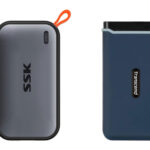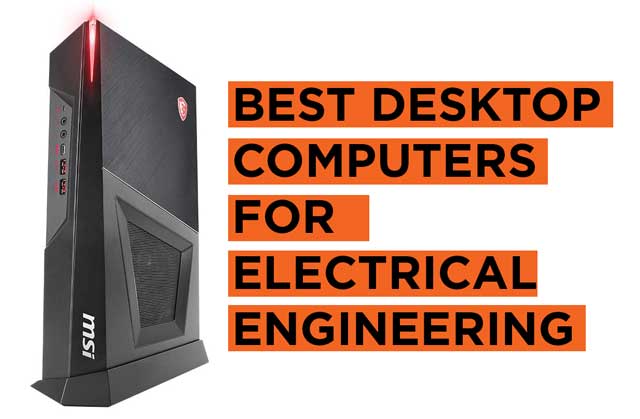This guide is for real-time 3D artists, game developers, virtual production teams, architectural visualizers, and anyone working inside Unreal Engine on a professional level. If you rely on Unreal to render immersive scenes, simulate physics, compile shaders, or drive virtual cameras, this is the system guide you’ve been waiting for.
Unreal Engine is unforgiving. It stretches your CPU, maxes your GPU, consumes RAM with endless assets, and writes to disk constantly. It’s not a typical rendering engine—it’s a full-spectrum, real-time creation platform. That means your hardware needs to be tuned not only for general performance but for consistent responsiveness across dynamic, parallel workloads.
he systems we recommend meet a set of technical minimums and are judged against specific performance criteria that matter in an Unreal workflow for compiling C++ builds, generating Lumen-based lighting, testing gameplay logic with hundreds of AI agents, and rendering cinematic sequences in real-time.
Let’s start with the CPU. Unreal Engine is deeply reliant on CPU power—especially when building lighting, compiling shaders, or running simulations. You need a processor with high clock speed and multiple cores. We recommend at least an AMD Ryzen 9 or Intel i9 with 12 to 16 physical cores, and clock speeds of 4.5GHz or higher. This ensures fast compile times, smoother editor performance, and fewer frame dips during testing.
Now to the GPU, which does the heavy lifting for real-time rendering, Nanite virtualized geometry, Lumen global illumination, and hardware ray tracing. Unreal Engine thrives on GPU power. For serious work, look at NVIDIA RTX 4070 Ti or better, with minimum 12GB of VRAM. Unreal’s real-time viewport, post-processing effects, and virtual camera pipelines demand this kind of GPU muscle. For virtual production or cinematic sequences using Unreal’s Movie Render Queue, even higher-end cards like the RTX 4090 or RTX 5090 are strongly advised.
RAM is your multitasking backbone. Unreal loads gigabytes of textures, blueprints, skeletal meshes, and environment data into memory. The engine alone can eat 16GB during a mid-sized session, so we recommend 64GB of DDR5 RAM as a baseline. This ensures you can run Unreal, your IDE, a version control client, a texture editor like Substance Painter, and browser tabs for documentation, all without paging to disk.
Next comes storage, and this is critical. Unreal Engine uses a ton of disk IO: loading asset-heavy scenes, caching shaders, saving autosaves, and indexing project folders. A 2TB NVMe SSD with PCIe Gen 4 support is the minimum here. Fast read/write speeds help with asset streaming, reduce compile bottlenecks, and allow faster scene switching. If you’re handling massive projects (AAA-scale or full virtual production environments), a secondary drive for storing backups or source assets is also valuable.
Thermal management can’t be overlooked. Unreal tasks can run your CPU and GPU at near-max load for hours. You need a system with high airflow, liquid or tower-class cooling, and a power supply with thermal headroom. Overheating causes throttling, which directly affects shader compiles and viewport responsiveness.
Let’s talk about display support. Many developers work on multi-monitor setups: one for the editor, one for the game viewport, and a third for code or debugging tools. You’ll need a GPU and motherboard combo that supports DisplayPort 1.4 or HDMI 2.1, with triple-display output capability. If you’re working in color-sensitive environments (for cinematics or archviz), support for HDR10, DCI-P3, or 10-bit color is a must.
Then there’s port selection and expansion capability. You need access to Thunderbolt or USB-C for fast asset transfer, multiple USB-A ports for peripherals, and PCIe slots for add-on cards—like capture cards, RED camera link interfaces, or sound hardware. A good desktop also gives you room to grow: extra DIMM slots for memory, space for additional SSDs, and an ATX or E-ATX motherboard that won’t limit future upgrades.
Expect a machine that launches the engine fast, compiles in minutes, runs simulations without a hitch, and renders cinematics in real time. We’re recommending desktops with the express purpose of empowering real-time creators. These are production-class workstations that can support anything from solo game development to full virtual set environments.
Also see: Best Desktop Computer for Blender
These are the Best Desktop Computers for Unreal Engine:
Contents
- Skytech Gaming Azure PC Desktop – AMD Ryzen 7 7800X3D 4.2 GHz, NVIDIA RTX 4090, 1TB NVME Gen4 SSD, 32GB DDR5
- Skytech Gaming Prism Gaming PC, Ryzen 7 7800X3D 4.2 GHz, RTX 4070 Ti, 1TB NVME, 32GB DDR5
- MSI Aegis RS Gaming Desktop Intel Core i7-13700KF, RTX 4070, 32GB DDR5, 2TB
- Skytech Gaming Nebula Gaming PC Desktop – Intel Core i5 13400F 2.5 GHz, NVIDIA RTX 4060, 1TB NVME SSD
- Corsair Vengeance i7500 Series Gaming PC - Liquid Cooled Intel Core i7 14700KF CPU - NVIDIA GeForce RTX 4070Ti GPU - 32GB
- Lenovo Legion Tower T5 Gaming Desktop, Intel Core i7-11700F Processor, GeForce RTX 3060, 32GB RAM, 1TB PCIe SSD + 2TB HDD
- Skytech Legacy Gaming PC, Ryzen 7 7800X3D 4.2 GHz, RTX 4080 Super, 2TB NVME Gen4, 32GB DDR5
Skytech Gaming Azure PC Desktop – AMD Ryzen 7 7800X3D 4.2 GHz, NVIDIA RTX 4090, 1TB NVME Gen4 SSD, 32GB DDR5 |
|
|---|---|
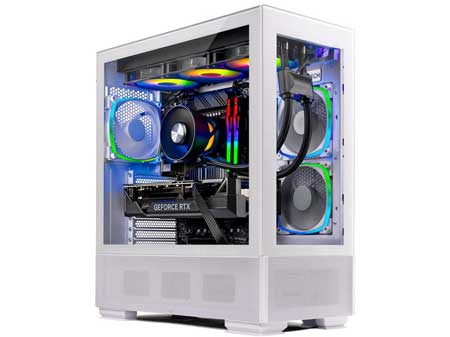 See This On Amazon |
|
| CPU | AMD Ryzen 7 7800X3D |
| Processor Speed | 4.2 GHz |
| GPU | NVIDIA RTX 4090 |
| Graphics Card Memory | 24 GB |
| RAM | 32GB DDR5 |
| Storage Space | 1TB NVME Gen4 SSD |
| Operating System | Windows 11 |
| Dimensions | 26 x 24.7 x 14.55 inches |
| Keyboard & Mouse | Sold Separately |
| Computer Monitor | Sold Separately |
| Advantages | Performance |
| Disadvantages | Price |
Skytech Gaming Prism Gaming PC, Ryzen 7 7800X3D 4.2 GHz, RTX 4070 Ti, 1TB NVME, 32GB DDR5 |
|
|---|---|
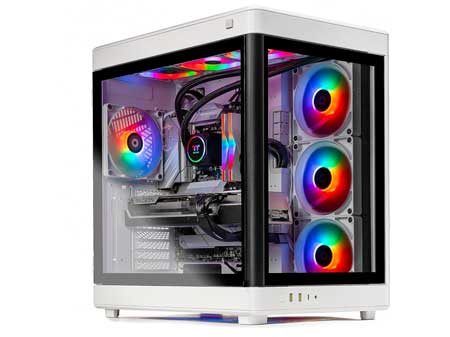 See This On Amazon |
|
| CPU | Ryzen 7 7800X3D |
| Processor Speed | 4.2 GHz |
| GPU | RTX 4070 Ti |
| Graphics Card Memory | 12 GB |
| RAM | 32GB DDR5 |
| Storage Space | 1TB NVME |
| Operating System | Windows 11 |
| Dimensions | 23.4 x 22.9 x 15.9 inches |
| Keyboard & Mouse | Sold Separately |
| Computer Monitor | Sold Separately |
| Advantages | Performnce |
| Disadvantages | n/a |
MSI Aegis RS Gaming Desktop Intel Core i7-13700KF, RTX 4070, 32GB DDR5, 2TB |
|
|---|---|
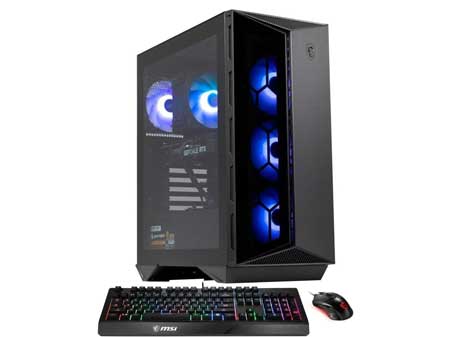 See This On Amazon |
|
| CPU | Intel Core i7-13700KF |
| Processor Speed | 2.5 GHz |
| GPU | RTX 4070 |
| Graphics Card Memory | 12 GB |
| RAM | 32GB DDR5 |
| Storage Space | 2TB M.2 NVMe |
| Operating System | Windows 11 |
| Dimensions | 25 x 23.25 x 12.4 inches |
| Keyboard & Mouse | Included |
| Computer Monitor | Sold Separately |
| Advantages | Performance, Price, Storage |
| Disadvantages | n/a |
Skytech Gaming Nebula Gaming PC Desktop – Intel Core i5 13400F 2.5 GHz, NVIDIA RTX 4060, 1TB NVME SSD |
|
|---|---|
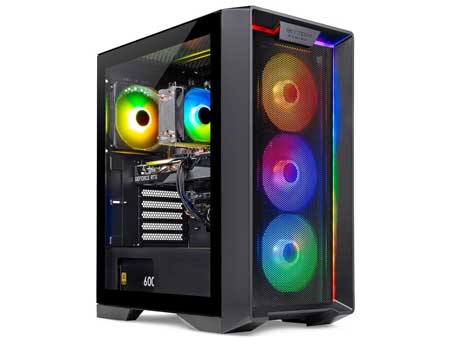 See This On Amazon |
|
| CPU | Intel Core i5 13400F |
| Processor Speed | 2.5 GHz |
| GPU | NVIDIA RTX 4060 |
| Graphics Card Memory | 8 GB |
| RAM | 16GB DDR4 |
| Storage Space | 1TB NVME SSD |
| Operating System | Windows 11 |
| Dimensions | 22.5 x 20.5 x 13.5 inches |
| Keyboard & Mouse | Sold Separately |
| Computer Monitor | Sold Separately |
| Advantages | Design and Build |
| Disadvantages | Storage |
Corsair Vengeance i7500 Series Gaming PC - Liquid Cooled Intel Core i7 14700KF CPU - NVIDIA GeForce RTX 4070Ti GPU - 32GB |
|
|---|---|
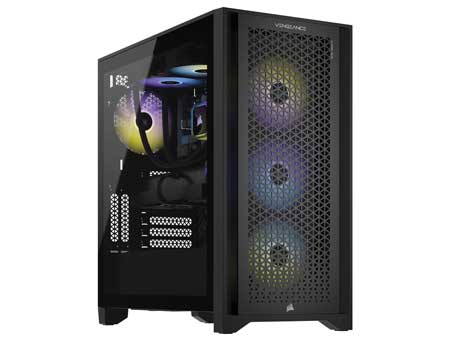 See This On Amazon |
|
| CPU | Intel Core i7 14700KF |
| Processor Speed | 3.4 GHz |
| GPU | NVIDIA GeForce RTX 4070Ti |
| Graphics Card Memory | 12 GB |
| RAM | 32GB |
| Storage Space | 1TB M.2 SSD |
| Operating System | Windows 11 |
| Dimensions | 17.8 x 9.1 x 18.3 inches |
| Keyboard & Mouse | Sold Separately |
| Computer Monitor | Sold Separately |
| Advantages | design and performance |
| Disadvantages | Storage |
Lenovo Legion Tower T5 Gaming Desktop, Intel Core i7-11700F Processor, GeForce RTX 3060, 32GB RAM, 1TB PCIe SSD + 2TB HDD |
|
|---|---|
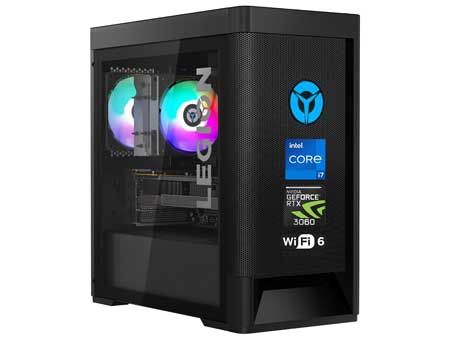 See This On Amazon |
|
| CPU | Intel Core i7-11700F Processor |
| Processor Speed | 2.5 GHz |
| GPU | Nvidia Ge Force Rtx 3060 |
| Graphics Card Memory | 12 GB |
| RAM | 32GB |
| Storage Space | 1TB PCIe SSD + 2TB HDD |
| Operating System | Windows 11 |
| Dimensions | 21.65 x 19.09 x 14.57 inches |
| Keyboard & Mouse | Sold Separately |
| Computer Monitor | Sold Separately |
| Advantages | Value for Money, Very good performance, Large storage |
| Disadvantages | N/A |
Skytech Legacy Gaming PC, Ryzen 7 7800X3D 4.2 GHz, RTX 4080 Super, 2TB NVME Gen4, 32GB DDR5 |
|
|---|---|
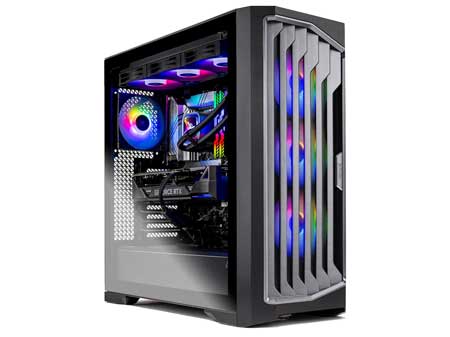 See This On Amazon |
|
| CPU | Ryzen 7 7800X3D |
| Processor Speed | 4.2 GHz |
| GPU | RTX 4080 Super |
| Graphics Card Memory | 16 GB |
| RAM | 32GB DDR5 |
| Storage Space | 2TB NVME |
| Operating System | Windows 11 |
| Dimensions | 24 x 23 x 13 inches |
| Keyboard & Mouse | Sold Separately |
| Computer Monitor | Sold Separately |
| Advantages | Value, Performance, Storage |
| Disadvantages | N/A |


